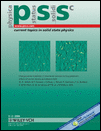Antiferromagnetic phase in doped semiconductors near the insulator–metal phase transition
Abstract
We show for n -type semiconductors, using Ge:As and 4H -SiC:N as examples, that the spin density measured by electron spin resonance (ESR) falls sharply near the insulator–metal (IM) transition. Two reasons might be responsible for this phenomenon: potential fluctuations with concentration of the electrons in local minima or local antiferromagnetic spin pairing (“spin glass”) in the insulating state just below the IM transition. In the investigated semiconductors manifestation of the latter is observed as a change from Curie to a Curie–Weiss behaviour with negative constant Θ. (© 2006 WILEY-VCH Verlag GmbH & Co. KGaA, Weinheim)




